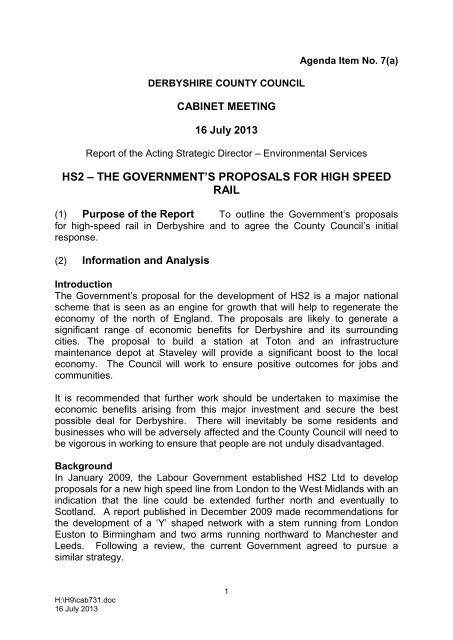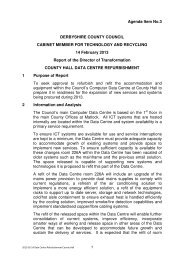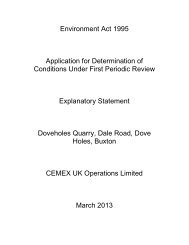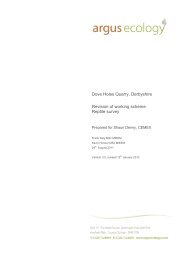HS2 The Government's proposals for High Speed Rail - Derbyshire ...
HS2 The Government's proposals for High Speed Rail - Derbyshire ...
HS2 The Government's proposals for High Speed Rail - Derbyshire ...
You also want an ePaper? Increase the reach of your titles
YUMPU automatically turns print PDFs into web optimized ePapers that Google loves.
DERBYSHIRE COUNTY COUNCIL<br />
CABINET MEETING<br />
16 July 2013<br />
Agenda Item No. 7(a)<br />
Report of the Acting Strategic Director – Environmental Services<br />
<strong>HS2</strong> – THE GOVERNMENT’S PROPOSALS FOR HIGH SPEED<br />
RAIL<br />
(1) Purpose of the Report To outline the Government’s <strong>proposals</strong><br />
<strong>for</strong> high-speed rail in <strong>Derbyshire</strong> and to agree the County Council’s initial<br />
response.<br />
(2) In<strong>for</strong>mation and Analysis<br />
Introduction<br />
<strong>The</strong> Government’s proposal <strong>for</strong> the development of <strong>HS2</strong> is a major national<br />
scheme that is seen as an engine <strong>for</strong> growth that will help to regenerate the<br />
economy of the north of England. <strong>The</strong> <strong>proposals</strong> are likely to generate a<br />
significant range of economic benefits <strong>for</strong> <strong>Derbyshire</strong> and its surrounding<br />
cities. <strong>The</strong> proposal to build a station at Toton and an infrastructure<br />
maintenance depot at Staveley will provide a significant boost to the local<br />
economy. <strong>The</strong> Council will work to ensure positive outcomes <strong>for</strong> jobs and<br />
communities.<br />
It is recommended that further work should be undertaken to maximise the<br />
economic benefits arising from this major investment and secure the best<br />
possible deal <strong>for</strong> <strong>Derbyshire</strong>. <strong>The</strong>re will inevitably be some residents and<br />
businesses who will be adversely affected and the County Council will need to<br />
be vigorous in working to ensure that people are not unduly disadvantaged.<br />
Background<br />
In January 2009, the Labour Government established <strong>HS2</strong> Ltd to develop<br />
<strong>proposals</strong> <strong>for</strong> a new high speed line from London to the West Midlands with an<br />
indication that the line could be extended further north and eventually to<br />
Scotland. A report published in December 2009 made recommendations <strong>for</strong><br />
the development of a ‘Y’ shaped network with a stem running from London<br />
Euston to Birmingham and two arms running northward to Manchester and<br />
Leeds. Following a review, the current Government agreed to pursue a<br />
similar strategy.<br />
H:\H9\cab731.doc<br />
16 July 2013<br />
1
A report on high speed rail was considered by Cabinet on 21 June 2011<br />
(Minute No. 185/11 refers). This outlined the Government’s overall strategy<br />
<strong>for</strong> the development of the ‘Y’ network of high speed rail lines. <strong>The</strong> <strong>proposals</strong><br />
envisage a double track electrified railway with trains travelling at up to<br />
225mph. <strong>The</strong> overall cost of the project is currently estimated to be £32bn and<br />
the planned opening date of the Birmingham - Leeds and Birmingham –<br />
Manchester sections is 2032/33.<br />
<strong>The</strong> Government announced its ‘initial preferred route’ <strong>for</strong> both sections on 28<br />
January 2013. <strong>The</strong> broad strategy remains unchanged but the announcement<br />
provided, <strong>for</strong> the first time, plans and profiles of the route, and a substantial<br />
quantity of supporting in<strong>for</strong>mation.<br />
<strong>The</strong> Birmingham – Manchester section (including a new station at Manchester<br />
Airport) will not directly affect <strong>Derbyshire</strong>, although residential and businesses<br />
in the <strong>High</strong> Peak of the County may benefit from the greatly reduced journey<br />
times to Birmingham and London. <strong>The</strong> Journey time from Manchester to<br />
London will be reduced from 2 hours 8 minutes to 1 hour 8 minutes. Whilst the<br />
journey time from Manchester Airport to London will be just under 1 hour. A<br />
new high speed rail station at Piccadilly will unlock significant potential<br />
regeneration and the associated development is expected to support nearly<br />
30,000 jobs, providing potential economic benefits to the north-west of the<br />
County.<br />
<strong>The</strong> plans <strong>for</strong> the Birmingham – Leeds section make provision <strong>for</strong> a new<br />
station at Toton to serve the East Midlands, and near Meadowhall to serve<br />
South Yorkshire. An infrastructure maintenance depot is proposed <strong>for</strong> the<br />
<strong>for</strong>mer Staveley Works site. It is proposed to serve this by means of a short<br />
spur from the main line.<br />
<strong>The</strong> announcement also included <strong>proposals</strong> <strong>for</strong> an ‘exceptional hardship<br />
scheme’ to help house owners and small businesses who are able to show<br />
that they are unable to sell their property due to the blighting effect of the<br />
scheme. At a later date, a compensation scheme will be introduced to help all<br />
land owners directly affected by the scheme.<br />
At the time of the announcement, the Council welcomed the idea that the East<br />
Midlands station would be at Toton.<br />
Brief Description of the Route through <strong>Derbyshire</strong><br />
A plan showing the approximate line of the route through <strong>Derbyshire</strong> is<br />
attached as an Appendix to this report.<br />
<strong>The</strong> Birmingham - Leeds section of the route will leave the main London -<br />
Birmingham/Manchester section of the route near Water Orton in the West<br />
Midlands and follow the M42/A42 corridor passing through a tunnel under<br />
H:\H9\cab731.doc<br />
16 July 2013<br />
2
East Midlands Airport. <strong>The</strong> route enters <strong>Derbyshire</strong> south of Long Eaton, and<br />
runs north through a largely residential area of the town on the alignment of<br />
the current ‘low level’ railway. <strong>The</strong> existing tracks will be relocated on to the<br />
nearby ‘high level’ route. <strong>The</strong> high speed line continues north to the Toton<br />
Sidings area where a new station will be provided <strong>for</strong> high speed services,<br />
together with an adjacent station <strong>for</strong> local rail services.<br />
North of Toton, the new line initially follows the existing rail corridor, then<br />
heads in a north-easterly direction broadly following the M1 corridor into<br />
Nottinghamshire, be<strong>for</strong>e re-entering <strong>Derbyshire</strong> east of Junction 28.<br />
<strong>The</strong> route rejoins the motorway corridor near Tibshelf, crossing to the west<br />
side of the motorway south of Hardwick Hall, and continues through Junction<br />
29, be<strong>for</strong>e crossing back to the east of the motorway. It continues on the east<br />
side of the motorway be<strong>for</strong>e passing through Markham Vale, where there is a<br />
significant impact on development land. <strong>The</strong> route then leaves the motorway<br />
corridor and continues in a northerly direction passing immediately west of<br />
Woodthorpe and under the A619 between Staveley and Mastin Moor. From<br />
here a short spur from the main line will run north of Lowgates to the site of a<br />
proposed infrastructure maintenance depot at the Staveley Works site. <strong>The</strong><br />
main route then continues north towards South Yorkshire, on the west side of<br />
Renishaw and Killamarsh.<br />
<strong>The</strong> in<strong>for</strong>mation published as part of the announcement shows the wide range<br />
of options that were considered as part of the evaluation process. It is evident<br />
that a number of the route options, had they been chosen, would have had a<br />
significantly greater impact on <strong>Derbyshire</strong>.<br />
Toton Station (‘East Midlands Hub’)<br />
<strong>The</strong> proposed station, which is being described by <strong>HS2</strong> Ltd as the ‘East<br />
Midlands Hub’ will provide two island plat<strong>for</strong>ms (four plat<strong>for</strong>m faces) and two<br />
through lines. Adjoining this, immediately to the east, will be a new four<br />
plat<strong>for</strong>m station <strong>for</strong> conventional rail services. It is envisaged that this will be<br />
served by new and diverted rail services with potential connections to<br />
Dronfield, Chesterfield, Alfreton, Langley Mill, the proposed new station at<br />
Ilkeston and, possibly, other <strong>Derbyshire</strong> stations such as those currently<br />
served by Matlock – Derby - Nottingham services.<br />
A new junction with the A52 is proposed to the east of junction 25, as is an<br />
extension of the Nottingham NET tram service from its currently proposed<br />
terminus at Chilwell.<br />
<strong>The</strong> pattern of services on the high speed line will be determined nearer to the<br />
time of opening but, currently, it is envisaged that the new station would be<br />
served by:<br />
• 3 trains per hour to London<br />
H:\H9\cab731.doc<br />
16 July 2013<br />
3
• 3 trains per hour to Birmingham<br />
• 5 trains per hour to South Yorkshire and Leeds.<br />
It should be noted that some high speed services will run as through services<br />
and will not stop at Toton.<br />
<strong>The</strong> project would greatly increase capacity and result in much faster journey<br />
times, not just to London, but also between regional centres. Estimated<br />
journey times from Toton are:<br />
London<br />
Birmingham<br />
Sheffield<br />
Leeds<br />
51 mins<br />
19 mins<br />
17 mins<br />
28 mins<br />
Proposed Infrastructure Maintenance Depot<br />
<strong>The</strong> <strong>proposals</strong> include provision <strong>for</strong> an infrastructure maintenance depot at<br />
Staveley which is to be served by a short spur from the main line and a<br />
junction providing access to the high speed line to the north and south. <strong>The</strong><br />
site meets <strong>HS2</strong> Ltd’s operational requirements in that it is roughly midway<br />
between Birmingham and Leeds, provides sufficient space to accommodate<br />
long maintenance trains and offers convenient access to the conventional and<br />
high speed rail networks. It is the currently preferred location <strong>for</strong> the depot.<br />
<strong>The</strong> depot is the base from which track, signalling and the overhead electric<br />
supply will be maintained. Much of the work will be undertaken at night when<br />
the line is not being used. Only limited details are available about the<br />
proposed depot, and the employment potential has been variously estimated<br />
at between 200 and 500 jobs. Many of these are likely to be of a technical<br />
nature and will require varying levels of skill.<br />
At present, no details are available about the construction of the route, but it<br />
seems to be a reasonable assumption that any site identified as a<br />
maintenance site could also be used as a construction site as the scheme is<br />
being developed. This suggests that there may be further job opportunities<br />
and the potential to secure investment in associated infrastructure, including<br />
improvements to the local road network.<br />
Part of the site has been identified <strong>for</strong> major housing development and<br />
consideration will need to be given to the scope <strong>for</strong> revising existing<br />
development plans in order to accommodate the depot <strong>proposals</strong>. To this<br />
end, County Council officers are liaising with Chesterfield Borough Council to<br />
maximise any benefits arising from the proposal and to ensure compatibility<br />
with other development <strong>proposals</strong> <strong>for</strong> the area.<br />
H:\H9\cab731.doc<br />
16 July 2013<br />
4
In view of the potential economic benefits to the area, it is recommended that<br />
officers should work with <strong>HS2</strong> Ltd and Borough Council partners to develop an<br />
acceptable scheme <strong>for</strong> the provision of this facility.<br />
Government’s Timetable<br />
<strong>The</strong> timetable <strong>for</strong> developing the project in the short/medium term is as<br />
follows:<br />
28 Jan 2013 Secretary of State announced ‘initial preferred route’<br />
Spring 2013<br />
Summer 2013<br />
Late 2013/Early<br />
2014<br />
In<strong>for</strong>mal engagement with local authorities<br />
Announcement of arrangements <strong>for</strong> public consultation<br />
(expected to last <strong>for</strong> approximately 6 months)<br />
Deadline <strong>for</strong> responses from individuals, local authorities,<br />
and other organisations<br />
Summer 2014<br />
Late 2014<br />
<strong>HS2</strong> Ltd considers responses to consultation and refine<br />
the route<br />
Secretary of State announces decision<br />
Key Issues<br />
Responding to the Consultation<br />
<strong>The</strong> Government has developed the current <strong>proposals</strong> and strategic decisions<br />
about the scheme, <strong>for</strong> example, about its broad alignment and af<strong>for</strong>dability,<br />
will be made at a national rather than a local level. As such, fundamental<br />
decisions about the scheme are outside the County Council’s control. In these<br />
circumstances, it is considered that the interests of <strong>Derbyshire</strong>’s residents<br />
would be best served through constructive engagement with the scheme’s<br />
promoters. This approach would seek to take advantage of any opportunities<br />
arising from the scheme while pressing hard <strong>for</strong> changes and refinements that<br />
would remove or mitigate the adverse impacts of the scheme.<br />
A deadline <strong>for</strong> the end of the consultation period has yet to be announced, but<br />
it is likely that the County Council will need to <strong>for</strong>mulate its response to the<br />
<strong>proposals</strong> by the end of 2013. A large quantity of in<strong>for</strong>mation has been<br />
published which needs to be assimilated and its implications properly<br />
understood. Further understanding will be gained by effective engagement<br />
with parties directly affected by the scheme and, where necessary, by<br />
undertaking further investigations into the impact of the scheme.<br />
Localised and Strategic Economic Benefits of <strong>HS2</strong><br />
Government studies set out arguments that <strong>HS2</strong> will generate major direct<br />
impacts from both construction and operational phases of the system. <strong>The</strong><br />
strategic justification of the proposal is based around two concepts: (a)<br />
unlocking the potential of the city regions of the Midlands/North <strong>for</strong> high value<br />
H:\H9\cab731.doc<br />
16 July 2013<br />
5
sectors and allowing them to compete with other “well connected” European<br />
city economies; and (b) this providing “engine” growth stimulus to wider city<br />
region hinterlands <strong>for</strong> a range of sectors; both conventional and those more<br />
closely associated with <strong>HS2</strong>.<br />
While Government predictions of job creation levels have been questioned,<br />
the positive implications of the <strong>HS2</strong> project need to be considered on a local<br />
basis, specifically in terms of currently disadvantaged communities.<br />
Notwithstanding current uncertainty on the magnitude of impact, a range of<br />
evidence from other national economies suggests it is likely that overall<br />
economic benefits generated by the construction and operational phases of<br />
<strong>HS2</strong> will be substantial. Specifically, experience from other high speed rail<br />
investments demonstrate that such services add most economic value when<br />
they connect core cities. However, the spatial distribution of wider,<br />
consequential benefits will be extremely uneven. For <strong>Derbyshire</strong>, this poses a<br />
further challenge to evaluate benefits, as the County will be affected by a<br />
complex interplay of influences and impacts from surrounding major urban<br />
areas.<br />
<strong>The</strong> possible range of economic benefits <strong>for</strong> <strong>Derbyshire</strong> fall within several<br />
broad headings:<br />
Potential direct effects from the Toton Station and the Maintenance Depot at<br />
Staveley will be relatively easy to model using conventional economic impact<br />
assessment techniques. This is because they are major inward investments<br />
based upon specific, fixed locations, in essence they are similar to any other<br />
major development. On this basis, it is proposed that the County Council<br />
should contribute to the studies on these specific matters, such as that being<br />
undertaken by Nottingham City, County and Broxtowe Borough Council.<br />
<strong>The</strong>re will be sector-specific industries that will benefit from specific<br />
construction, infrastructure and technology procurement supply chains. This<br />
could include advanced materials industries in Sheffield, rail engineering in<br />
Derby and the nationally important role of <strong>Derbyshire</strong> minerals suppliers <strong>for</strong><br />
specialist cements and construction aggregates.<br />
<strong>The</strong> strategic benefits of the <strong>HS2</strong> proposal will fall locally into two main areas:<br />
• <strong>The</strong> direct spin off from <strong>HS2</strong> stimulated growth in specific high value<br />
sectors in the cities. Knowledge/service sectors such as finance,<br />
professional services, digital/creative and technology are likely to benefit<br />
significantly from greater connectivity with London and European cities.<br />
However, the direct actual job creation is expected to be relatively tightly<br />
constrained to the location of stations or direct feed in points. While this<br />
may change over time, in early operational years it is likely that it will be<br />
H:\H9\cab731.doc<br />
16 July 2013<br />
6
hard to change the inertia of business location, particularly <strong>for</strong> the<br />
business sectors most influenced by <strong>HS2</strong> to be clustered in cities.<br />
• <strong>The</strong>re will be a wider strengthening of the local economies as the<br />
directly stimulated growth creates multiplier effects. This will result in a<br />
general uplift in economic activity of all types.<br />
Both of these issues will fuel further consequential growth. <strong>The</strong>re also could<br />
be an improvement of the image of <strong>Derbyshire</strong> and its surrounding cities as<br />
“quality places”. <strong>HS2</strong> connections are likely to enhance the perception of area,<br />
improving the attractiveness <strong>for</strong> development and, in turn, influencing<br />
locational decisions <strong>for</strong> businesses. <strong>The</strong>re will be perception that being<br />
connected to a high-speed rail link leads to a positive economic influence,<br />
particularly in the location of offices.<br />
<strong>The</strong>se issues will also stimulate the wider economic areas which support<br />
employment in <strong>Derbyshire</strong> businesses. However, there is a need <strong>for</strong> robust<br />
analysis of the range of initiatives needed to deliver growth <strong>for</strong> communities so<br />
they can capitalise on this opportunity. <strong>The</strong>se will need to be a combination of<br />
specific initiatives and more conventional regeneration approaches to equip<br />
communities with the right attributes to take advantage of more general<br />
growth.<br />
<strong>The</strong> totality of these effects could, as noted be<strong>for</strong>e, be extremely substantial,<br />
particularly if strong two way linkages are developed with growing cities<br />
surrounding the County.<br />
All of these economic issues pose challenges <strong>for</strong> the County in coming to a<br />
considered view on some key issues:<br />
1. Without full understanding of the complex interrelationships of these<br />
economic factors, including timescales, the evaluation of the balance of<br />
overall environmental acceptability of the <strong>HS2</strong> scheme has to be made<br />
on a series of assumptions of strategic, local and consequential<br />
benefits.<br />
2. <strong>The</strong>re will need to be an urgent investigation to the possible range of<br />
actions to properly realise localised regeneration benefits. <strong>The</strong>re will<br />
need to be an acceptance that these benefits will accrue to a significant<br />
degree by virtue of the greater comparative and competitive strength of<br />
local economies. On this basis, there will need to be a particular<br />
emphasis on strengthening and aligning regeneration initiatives,<br />
including skills.<br />
A national project has recently been announced (June 2013) on delivering<br />
such benefits. A task <strong>for</strong>ce, led by Lord Deighton, Commercial Secretary to<br />
the Treasury, will investigate how best to secure maximum economic gains<br />
H:\H9\cab731.doc<br />
16 July 2013<br />
7
from the <strong>HS2</strong> project. It is suggested that this work will provide a useful<br />
underpinning <strong>for</strong> joint working with Districts/Boroughs and adjoining local<br />
authorities to realise jobs and economic growth <strong>for</strong> <strong>Derbyshire</strong>.<br />
Transport Impacts<br />
<strong>The</strong>re are potential transport benefits associated with the concept of a new<br />
‘hub’ station at Toton, the use of released capacity on the Midland Main Line<br />
and the potential <strong>for</strong> investment in new infrastructure at the station and the<br />
proposed maintenance depot. <strong>The</strong> extent of these benefits, however, needs to<br />
be properly evaluated and consideration given to potential disadvantages and<br />
risks. For example, the additional provision <strong>for</strong> long distance rail travel will<br />
enable some capacity on the Midland Main Line to be released. This should<br />
offer opportunities <strong>for</strong> new passenger and freight services to be provided but it<br />
will be important to ensure that this is not at the expense of passengers using<br />
conventional rail services who may experience less convenient journeys or the<br />
effects of reduced investment.<br />
It should be noted that the current plans make no provision <strong>for</strong> a connection to<br />
the conventional rail network in the East Midlands. It is suggested that this is<br />
a matter that should be investigated further, together with the potential to<br />
make use of ‘classic compatible’ train services able to operate on both the<br />
high speed and the conventional rail networks.<br />
Similarly, the proposed hub station at Toton has the potential to provide an<br />
interchange facility, particularly if there are good local connections, <strong>for</strong><br />
example, through an extension of the NET tram service. Again, however, it<br />
will be important to ensure that a need to serve a new station at Toton does<br />
not unduly disadvantage passengers using existing local services.<br />
Other Impacts of the Proposals<br />
It is clear, however, that the scheme will give rise to a number of negative<br />
impacts, both generally and at specific locations affecting individuals and<br />
communities. <strong>The</strong> County Council will need to be vigorous in pressing <strong>for</strong><br />
measures to eliminate or mitigate the adverse impacts of the scheme.<br />
At this relatively early stage and in advance of public consultation, it is difficult<br />
to comment in detail on all the implications of the <strong>proposals</strong> but some of the<br />
key concerns, in addition to those outlined above, that have already emerged<br />
include:<br />
• Visual intrusion and noise effects on residential and other sensitive<br />
locations, particularly where the route passes through or close to<br />
communities such as Long Eaton, Killamarsh, Renishaw and<br />
Woodthorpe. Residents who can show they have a need to move house<br />
and that the <strong>proposals</strong> are affecting their ability to sell, may be eligible<br />
<strong>for</strong> compensation under the Exceptional Hardship Scheme.<br />
H:\H9\cab731.doc<br />
16 July 2013<br />
8
• <strong>The</strong> <strong>proposals</strong> will have an impact on existing and proposed<br />
employment sites. <strong>The</strong> most significant impact is at Markham Vale<br />
where the land taken by the scheme would reduce the land available <strong>for</strong><br />
development. Concerns about this have been raised with <strong>HS2</strong> Ltd.<br />
• <strong>The</strong> published plans indicate that the <strong>HS2</strong> Ltd <strong>proposals</strong> and the<br />
associated maintenance depot will impact on the route of the<br />
Chesterfield Canal, which is currently being restored, at four separate<br />
locations. In order to maximise the economic, recreational and<br />
ecological value of the Canal, it is essential that it is restored as a<br />
continuous navigable waterway. Officers from the County Council,<br />
Chesterfield Borough Council and representatives from the Chesterfield<br />
Canal Trust have met <strong>HS2</strong> Ltd to explain their concerns, not only about<br />
the direct impact on the route of the Canal, but also the threat to funding<br />
opportunities as a result of the blight and uncertainty. <strong>The</strong> Cabinet<br />
Member <strong>for</strong> Jobs, Employment and Transport has recently written to<br />
Toby Perkins MP in order to secure a meeting with Government officials<br />
to discuss the concerns about funding in more detail.<br />
• <strong>The</strong> proposed scheme will cross highways and rights of way along the<br />
length of the route. <strong>The</strong> published plans show the main structures that<br />
would be provided as part of the scheme, including road bridges over<br />
and under the new railway. At this stage, these details are likely to be<br />
little more than indicative of the <strong>proposals</strong> and the County Council will<br />
need to ensure that its interests as local <strong>High</strong>way Authority are fully<br />
protected. In Long Eaton, two level crossings will need to be closed and<br />
<strong>HS2</strong> Ltd is currently investigating alternative access arrangements.<br />
Consideration will also need to be given to the impact on footpaths and<br />
rights of way, including the suitability of any crossings or diversions that<br />
may be proposed.<br />
• <strong>The</strong> new station can be expected to generate additional traffic and it will<br />
be important to ensure that the scheme does not exacerbate existing<br />
traffic problems in the area. <strong>The</strong>se concerns have been discussed with<br />
<strong>HS2</strong> Ltd and it is currently exploring in more detail access arrangements<br />
<strong>for</strong> Toton station. In doing so, it will be important to ensure that good<br />
provision is made <strong>for</strong> people who do not have access to a car or who<br />
may prefer to access the station by public transport or by some other<br />
means, eg cycling. <strong>The</strong> potential <strong>for</strong> extending the tram service and<br />
improved local train and bus services needs to be fully investigated.<br />
• More generally, there are issues that will need to be considered about<br />
the impact of the <strong>proposals</strong> on the natural and built environment, on<br />
opportunities <strong>for</strong> in<strong>for</strong>mal recreation, and on the County Council’s land,<br />
property and countryside interests. <strong>The</strong>re will also be considerable<br />
disruption during the construction phase of the work. It may be possible<br />
to reduce or mitigate some of these impacts through detailed design<br />
and appropriate mitigation measures and, again, these will need to be<br />
explored in more detail with <strong>HS2</strong> Ltd.<br />
H:\H9\cab731.doc<br />
16 July 2013<br />
9
Actions to Date<br />
Public consultation on the <strong>proposals</strong> will start later this summer and this will<br />
provide an opportunity <strong>for</strong> those affected by the scheme to get a better<br />
understanding of the <strong>proposals</strong> and their potential impact. <strong>The</strong>re are, however,<br />
a number of issues that officers are currently pursuing with the project’s<br />
promoters as outlined above. Some initial discussions have also taken place<br />
about <strong>HS2</strong> Ltd’s <strong>proposals</strong> <strong>for</strong> public consultation. Officers have stressed the<br />
importance of effective consultation and making sure that as many people as<br />
possible have the opportunity to attend the planned ‘roadshows’. Further<br />
reports on these and other issues will be presented <strong>for</strong> Members’<br />
consideration in due course.<br />
It is also helpful in this ‘pre-consultation’ period to seek to gain a better<br />
understanding of the impact of the <strong>proposals</strong> and, where appropriate, to obtain<br />
the views of partner organisations. Establishing a common understanding and<br />
approach to issues arising from the project will also strengthen the position of<br />
the Authority and its partners in any discussions over issues of concern.<br />
Preliminary discussions have taken place with District Councils on the line of<br />
the route and a County Council Officer is acting as a point of contact with <strong>HS2</strong><br />
Ltd, with the aim of co-ordinating, as far as may be possible, a response from<br />
all <strong>Derbyshire</strong> local authorities.<br />
<strong>The</strong> <strong>proposals</strong> have potential implications <strong>for</strong> a wide range of the Council’s<br />
interests and a cross-departmental officer group will help to facilitate<br />
consideration of the <strong>proposals</strong> and, in due course, co-ordinate the County<br />
Council’s detailed response. It is thought that any response from the County<br />
Council would focus on strategic issues of principle, leaving comments of an<br />
individual or very specific nature to be channelled direct to the scheme’s<br />
promoters through the public consultation process.<br />
Conclusions<br />
Strategic decisions about the scheme will be taken at a national rather than at<br />
a local level. <strong>The</strong> County Council’s primary focus should be on seeking to<br />
maximise local benefits that may arise from the scheme and reducing or<br />
mitigating the adverse effects.<br />
It is there<strong>for</strong>e recommended that at this stage, the County Council should give<br />
broad support to the <strong>proposals</strong> and should welcome, in particular, the<br />
<strong>proposals</strong> to locate a station to serve the East Midlands at Toton and to<br />
provide an infrastructure maintenance depot at Staveley. In order to maximise<br />
the benefits <strong>for</strong> <strong>Derbyshire</strong>, it will nevertheless be important to understand the<br />
concerns of individuals, businesses and other organisations, to engage<br />
effectively with <strong>HS2</strong> Ltd and to promote and encourage a co-ordinated<br />
approach from <strong>Derbyshire</strong> authorities. <strong>The</strong> Authority will need to be vigorous<br />
in working to maximise the opportunities arising from the scheme, in seeking<br />
effective integration of the scheme with conventional rail services and<br />
H:\H9\cab731.doc<br />
16 July 2013<br />
10
pressing <strong>for</strong> changes in design and other measures to reduce the adverse<br />
effects of the scheme.<br />
(3) Financial Considerations <strong>The</strong> Government will be responsible <strong>for</strong><br />
meeting the capital costs of the scheme and it has set a funding envelope of<br />
£42.6bn <strong>for</strong> construction costs and £7.5bn <strong>for</strong> rolling stock (2011 prices). If<br />
appropriate, an oral update will be provided at the meeting. In seeking to<br />
secure the best deal <strong>for</strong> <strong>Derbyshire</strong>, it is likely that revenue costs will be<br />
incurred in funding further studies and investigations, in meeting additional<br />
staff costs, possibly including a dedicated Project Officer, and associated<br />
costs. <strong>The</strong>se matters will be the subject of a separate report to the Cabinet<br />
Member <strong>for</strong> Jobs, Employment and Transport.<br />
(4) Environmental and Health Considerations <strong>The</strong> project would<br />
provide more sustainable travel opportunities <strong>for</strong> some people who might<br />
otherwise use a private car. <strong>The</strong>re are, however, some significant adverse<br />
impacts, including demolition, visual intrusion and noise impacts. Discussions<br />
with <strong>HS2</strong> Ltd and the Department <strong>for</strong> Transport (DfT) will focus on removing or<br />
mitigating any adverse impacts and maximising any opportunities <strong>for</strong><br />
enhancement of existing facilities.<br />
(5) Transport Considerations <strong>The</strong> <strong>HS2</strong> Ltd <strong>proposals</strong> will not only<br />
provide faster journey times between regional centres, but will also greatly<br />
increase the rail network’s capacity to meet the growth in demand. It can be<br />
anticipated that a significant proportion of existing rail passengers would<br />
transfer to the new faster service and this will release capacity <strong>for</strong> new<br />
passenger and freight services on the Midland Main Line. It will be important<br />
to ensure, however, that <strong>Derbyshire</strong> passengers continue to enjoy a good<br />
level of service as a result of any changes that may emerge.<br />
<strong>The</strong> proposal to serve the <strong>HS2</strong> station at Toton with new public transport<br />
services is to be welcomed, not least because it will help to reduce pressures<br />
on the local road network, but careful planning will be needed to minimise any<br />
adverse impact on existing local rail services.<br />
<strong>The</strong> Authority will also need to keep abreast of developments in ‘classic<br />
compatible’ trains capable of running on both high speed and conventional<br />
routes and of the potential to improve links between the high speed and<br />
conventional rail networks.<br />
In preparing this report the relevance of the following factors has been<br />
considered: legal, prevention of crime and disorder, equality and diversity,<br />
human resources and property considerations.<br />
(6) Key Decision Yes.<br />
H:\H9\cab731.doc<br />
16 July 2013<br />
11
(7) Call-In Is it required that call-in be waived in respect of the<br />
decisions proposed in the report? No.<br />
(8) Background Papers Report to Cabinet dated 21 June 2011.<br />
In<strong>for</strong>mation on high speed rail <strong>proposals</strong> available on <strong>HS2</strong> Ltd and DfT<br />
websites. An overview of the Phase 2 <strong>proposals</strong> is available on <strong>HS2</strong> Ltd’s<br />
website at http://www.hs2.org.uk/phase-two and detailed plans can be seen<br />
on the Department <strong>for</strong> Transport’s website at https://www.gov.uk/hs2-phasetwo-initial-preferred-route-plan-and-profile-maps.<br />
Officer contact details –<br />
Steve Cannon, extension 38148.<br />
(9) OFFICER’S RECOMMENDATIONS That Cabinet:<br />
9.1 Notes the announcement of the alignment <strong>for</strong> <strong>HS2</strong> in <strong>Derbyshire</strong><br />
9.2 Supports in principle <strong>proposals</strong> <strong>for</strong> a new station at Toton and an<br />
infrastructure maintenance depot at Staveley.<br />
9.3 Requests officers, in consultation with District Councils and other<br />
organisations, to seek to reduce the negative impact of the scheme and<br />
to maximise the economic benefits <strong>for</strong> <strong>Derbyshire</strong> residents.<br />
9.4 Endorses the actions being taken as outlined in the report.<br />
9.5 Authorises the Cabinet Member <strong>for</strong> Jobs, Employment and Transport to<br />
consider further reports as appropriate, including consideration of the<br />
financial implications of responding to the Government’s <strong>proposals</strong>.<br />
Mike Ashworth<br />
Acting Strategic Director – Environmental Services<br />
H:\H9\cab731.doc<br />
16 July 2013<br />
12
















